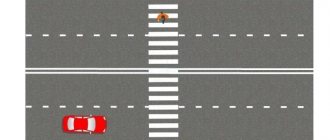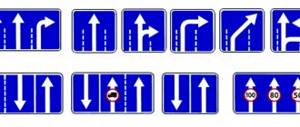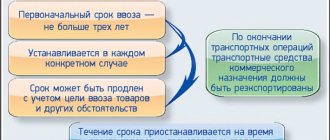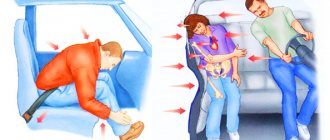Signs 5.16 - 5.18 “Bus (trolleybus), tram and taxi stop”
Signs 5.16 “Bus and (or) trolleybus stopping place”, 5.17 “Tram stopping place” and 5.18 “Taxi parking place” are used to designate stopping points of the corresponding types of route vehicles and passenger taxi parking.
Signs 5.16 “Bus and (or) trolleybus stopping place” are installed at the beginning of the landing area.
If there is a pavilion at a stopping point, then the stop sign can be installed on the pavilion above its closest edge in the direction of travel or on a separate support next to the pavilion.
When it is necessary to indicate the length of one or several stopping points located one after another, sign 5.16 “Bus and (or) trolleybus stopping place” is used with sign 8.2.1 “Validity area”. The sign is installed at the beginning of the first stopping point.
When tram tracks are located in the middle of the roadway (or to the left of a one-way roadway), sign 5.17 “Tram stopping place” is installed to the right of the roadway.
In some cases, when tram tracks are located in the middle of the roadway, the “Tram Stopping Place” sign is duplicated. Duplicate sign 5.17 is installed:
- if there is a raised landing area along the tram tracks - at the beginning of this area;
- on roads with two or more lanes in a given direction, if there is no landing pad - above the left lane.
It must be remembered that stopping or parking is prohibited closer than 15 meters from the stops of route vehicles or the parking of passenger taxis (clause 12.4 of the traffic rules). The starting point is the place where signs 5.16 - 5.18 are installed. This means 15 meters before and 15 meters after these signs, stopping and parking is prohibited.
Stopping is prohibited for any reason (except for stopping to pick up or disembark passengers, provided that this stop does not interfere with the movement of route vehicles or passenger taxis).
In places where route vehicles stop, turning around is still prohibited (clause 8.11 of the traffic rules).
The length of the route vehicle stop and taxi rank can be indicated by marking 1.17 (yellow zigzag). In this case, the prohibition on stopping (parking) and turning around applies throughout the entire yellow marking 1.17.
In populated areas, when driving past designated stops of route vehicles, you must also remember that clause 18.3 of the traffic rules obliges you to give way to trolleybuses and buses starting from the stop.
The issue of priority between route vehicles and other “non-route” traffic participants is discussed in the articles Driving past a stop of route vehicles and Priority of public transport.
Road sign “Bus or trolleybus stop”
The road sign “Bus or trolleybus stopping place” is placed at stopping points and indicates a section of the road for public transport . In such places it is strictly forbidden to turn around, park, or back up. are required to give way to buses moving from the drive-in pocket .
Have you ever needed the help of a car lawyer?
Types of bus stops
Stopping points are divided into two main types: stopping in a pocket and on the roadway. In the first case, the road is widened, in the second, route transport stops in the traffic lane. On the roadway, a stop is marked with a yellow oblique line. In addition, the stopping point includes:
- Passenger boarding area;
- Waiting area - pavilion, benches;
- Drive-in pocket for buses;
- There is a pedestrian crossing or path nearby;
- Garbage container, restroom.
Installation Rules
The road sign “Bus or trolleybus stopping place” is placed at the beginning of the landing area on a support or on a stopping pavilion.
The height of the base of the sign should not be less than 3 m from the ground surface.
If the length of the stop exceeds 13 m, or several stops are located in a row one after another, then the road sign is duplicated at the end of the landing area. Also, the length of the stopping point is indicated by a sign attached under the first sign in the direction of traffic.
What does the sign look like according to GOST?
Sign “Bus or trolleybus stop” 5.16 is a sign of special instructions. Externally it has a blue rectangular base, inside there is a picture of a bus on a white background. This sign works together with yellow road markings, in the form of a broken line or without it.
Parking of personal vehicles in the area covered by the sign is prohibited, but there are a few exceptions. You can stop the car:
- For 5 minutes to disembark a passenger or board a passenger. Provided that the car does not interfere with public transport and citizens waiting for the bus;
- Taxi, minibus driver;
- At a distance of 15 m before the stop and 15 m after it , without interfering with traffic. The distance is measured from the sign. If there is no sign, the counting starts from the boundary of the broken marking;
- In case of force majeure.
If a forced stop occurs in the event of an accident, breakdown, or due to the driver’s health, it is necessary to remove the car from the stopping point area as quickly as possible.
What if there is no sign?
The “Bus Stop Place” sign may be missing for various reasons: it broke down, they didn’t have time to install it, the stop point is new, etc. But if there are yellow markings, the stop is considered marked. On this segment, the same rules apply as for stops with a sign. If there is no sign or markings, there is no stop itself or it is inoperative.
Fines for failure to comply with sign requirements
For stopping or parking a car, the driver will be fined 1000 rubles. in accordance with Article 12.19 of the Code of Administrative Offenses of the Russian Federation, part 3.1. And if the traffic stop interferes with public transport, the fine increases to 2,000 rubles. Only forced stopping of the car is not fined.
For such a violation in St. Petersburg or Moscow, regardless of whether the car created interference or not, the fine will be 3,000 rubles.
For turning around near a stop - a fine of 1000 to 1500 rubles. according to Art. 12.16 Code of Administrative Offenses of the Russian Federation, part 2 .
If the driver does not give way to minibuses, the fine will be 500 rubles. according to Art. 12.17 part 1 of the Code of Administrative Offenses of the Russian Federation .
In addition to penalties, there is a provision for forced evacuation of the car to a penalty parking lot from the area of the sign if the owner left the car there and left.
Fine for violation - how to appeal?
You can prove your innocence at the scene of the violation if there is no road sign at the stop indicating a special area on the road. To impose a fine, the presence of a sign is required by traffic regulations. The driver did not violate anything if he parked in an unmarked area. This should be reported to a law enforcement officer in case of a dispute.
If you cannot prove your innocence to the traffic police inspector, you need to film the absence of a road sign on your mobile phone camera.
If the stopping point was marked, and the driver stopped to pick up a passenger without disturbing anyone, there is no violation . You can be fined for such actions only if there is evidence that the car was parked for more than 5 minutes or created a traffic jam.
In any case, if the driver does not agree with the decision of the road inspection representative, they go to court. All objections must be noted in the violation report. If witness testimony, photographs confirming innocence, or other evidence are presented, the penalty will be canceled.
Issues relating to motorists' rights are often more important than they appear at first glance. A driver may lose his license or suffer other severe penalties due to ignorance or misinterpretation of laws and regulations. Do not be lazy to dive deeply into the essence of the issue being studied, do not hesitate to ask advice from professionals.
Source: https://avtoproblema24.ru/pdd/znaki-dorozhnogo-dvizheniya/mesto-ostanovki-avtobusa/
Signs 5.19.1, 5.19.2 “Pedestrian crossing”
Signs 5.19.1 and 5.19.2 “Pedestrian crossing” are used to designate places intended for pedestrians to cross the road.
Sign 5.19.1 is installed on the right of the road, sign 5.19.2 on the left. On roads with a dividing strip (lanes), signs 5.19.1 and 5.19.2 are installed on the dividing strip, respectively, to the right or left of each roadway.
Sign 5.19.1, which is installed to the right of the road, is placed on the near border of the crossing relative to approaching vehicles, sign 5.19.2 - on the far one. The width of the pedestrian crossing, incl. which does not have zebra markings, is located between the lines on which the signs are installed.
Signs at a marked pedestrian crossing (markings 1.14.1, 1.14.2) are installed at a distance of no more than 1 meter from the boundaries of the crossing (from the markings).
At intersections it happens that the border of the marked (zebra) crossing closest to the center of the intersection coincides with the edge of the roadway. In other words, the pedestrian crossing seems to go beyond the border of the intersection or pass along its edge.
In this case, “Pedestrian crossing” signs may be installed only at the far border of the crossing, i.e. at the entrance to the intersection. The transition boundary is determined by the edge of the applied marking 1.14.1 or 1.14.2 (zebra).
Turning, stopping and parking of vehicles is prohibited at pedestrian crossings.
It is not prohibited to make a U-turn before or after a pedestrian crossing, unless there are other restrictions for this maneuver (for example, a solid center line marking).
Stopping and parking of vehicles is also prohibited within 5 meters of a pedestrian crossing. Immediately after the crossing, this ban is lifted unless there are other restrictions for it (for example, signs prohibiting stopping or parking are installed).
MTS stop sign only
in places where route vehicles stop.
closer than 15 meters from the stopping places of fixed-route vehicles or parking for passenger taxis, indicated by marking 1.17, and in its absence - from the sign of the stopping place of fixed-route vehicles or parking for passenger taxis (except for stops for boarding and disembarking passengers, if this does not interfere with the movement of fixed-route vehicles vehicles or vehicles used as passenger taxis);
Please note that the MTS stop location begins after the sign. According to GOST, sign 5.16 is installed at the beginning of the landing area, that is, the stopped route vehicle will be located completely after the sign. This prevents the bus from blocking the visibility of the sign. This is important when making a turn. Turning around before the sign is not prohibited. Turning is prohibited only at MTS stops - from the far right lane and into the far right lane.
If the stopping place for route vehicles is indicated only by a sign, then the prohibited stopping and parking zone is determined by 15 meters before and after the sign in the direction of travel for which the sign is installed. Stopping on the opposite side of the road is not prohibited.
Sign 5.20 “Artificial hump”
Sign 5.20 “Artificial Roughness” is used to indicate the boundaries of an artificial roughness.
The sign is installed on the nearest border of an artificial hump or marking 1.25 (indicating a road unevenness) relative to approaching vehicles.
Often, together with sign 5.20, you can see the prohibitory sign 3.24 “Maximum speed limit”. The coverage area of sign 3.24 does NOT end beyond the road bump.
Usually in such cases (next to the artificial bump), the speed limit sign is installed together with plate 8.2.1 “Validity area”, which indicates the coverage area of the prohibition sign.
If sign 3.24 “Maximum speed limit”, installed next to an artificial hump, is used without sign 8.2.1 “Value area”, then its coverage area lasts until the nearest intersection, or to another sign 3.24 with a different speed value.
An artificial unevenness is, after all, a bump, albeit of artificial origin. It can be large or small in size (there is a standard, but it may not be followed). In any case, driving over any unevenness, we can safely say that the car’s suspension is “strained.” To learn how not to damage your suspension, see the article How to drive over road bumps.
Experimental marking of tram stop locations
When organizing tram traffic with passengers disembarking on the roadway, for experimental purposes, in some places markings were applied to the right of the tram tracks along the left edge of the roadway.
Tram stop markings
This use of markup is for informational purposes only. Stopping in such a place is prohibited according to the general rules, and turning around without entering the tram tracks at the place where the tram stops will not work, that is, the markings do not affect the formation of a violation.
Source
Signs 5.21 “Residential zone” and 5.22 “End of residential zone”
Sign 5.21 “Residential zone” is used to designate the territory (zone) within which the requirements of the Road Traffic Rules, which establish the procedure for traffic in residential zones, apply. Sign 5.21 is installed at all entrances to residential areas.
Sign 5.22 “End of residential area” is used, accordingly, to indicate the end of a residential area. The sign is installed at all exits from residential areas. It may be placed on the reverse side of sign 5.21.
The rules for driving in courtyards and in areas marked with “Residential Zone” signs can be found in the article Driving in courtyards and residential areas from the Basics of Safe Driving series.
A complete list of road signs with special requirements with brief comments (explanations) on the website is posted in Appendix 1 of the Traffic Regulations.
Navigation through a series of articles<< Signs “Start of lane” and “End of lane” Signs Beginning and End of a populated area >>
Unmarked MTS stopping places
The above requirements of the Road Traffic Rules apply only to those indicated
stops of route vehicles and passenger taxis. If the stopping place is not marked with an appropriate sign and/or markings, turning around and stopping at such places is not prohibited.
Crowded places and arrangement on the sidewalk are not a sign of an MTS stop
The presence of route signs and transport schedules is not a sign of MTS stopping
Tram stop Wikipedia
The request "Bus stop" is redirected here;
see also other meanings. Stopping point
- a public stopping place for vehicles along the route of regular transportation, equipped for boarding, disembarking passengers and waiting for vehicles. Designed for boarding/disembarking passengers of regular ground public transport (bus, trolleybus, tram, minibus).
Description
Based on paragraph 11 of Article 2 of the Federal Law of November 8, 2007 N 259-FZ “Charter of Road Transport and Urban Ground Electric Transport” - a stopping point is a stopping place for vehicles along the route of regular transportation, equipped for boarding, disembarking passengers and waiting for vehicles. [1]
At each stopping point along the route of regular transportation, as required by paragraph 6 of Article 19 No. 259-FZ, information must be posted on the type of regular transportation of passengers and baggage, schedule, start and end time of movement of vehicles along the corresponding route, the name of the final stopping point of the route, information on the name, address and contact telephone numbers of the body exercising control over the regular transportation of passengers and baggage. The composition of information included in the schedule is determined by the rules of passenger transportation.[2]
In accordance with paragraph 5 of Article 3 of the Federal Law of November 8, 2007 N 257-FZ “On Highways and Road Activities in the Russian Federation”, a stopping point is an element of the development of highways.[3]
Based on paragraph 7 of Article 16 of the Federal Law of October 6, 2003 N 131-FZ “On the general principles of organizing local self-government in the Russian Federation,” the municipality (executive body of local government) is entrusted with the duty and responsibility for creating conditions for the provision of transport services to the population and organizing transport services population within the boundaries of the urban district.[4][5] Paragraph 27 of Article 16 relates to the municipality the issues of assigning names of elements of the road network, in accordance with the Charter of the municipality. (Renaming the names of stopping points: at the initiative of public groups, legal entities and the municipality).[6]
In accordance with Article 13.1 of the Federal Law of 08.11.2007 No. 257 “On Highways”, paragraph 6 of Article 3.1 of the Federal Law of 08.11.2007 N 259-FZ “Charter of Automobile Transport and Urban Ground Electric Transport” and the Decree of the Government of the Russian Federation of 09.06. 2010 N 409 “On the implementation of control (supervisory) functions by officials of the Federal Service for Supervision in the Sphere of Transport.” State supervision over the condition of stopping points is entrusted to the territorial departments of the transport inspection Rostransnadzor.[7][8][9][10]
Based on paragraph 6 of Article 30 of the Federal Law of December 10, 1995 N 196-FZ “On Road Safety”, an on-site unscheduled inspection is carried out at the request of citizens and organizations immediately, with notification to the prosecutor’s office.[11][12]
Types of stops
There are two main types of stops:
- Constant stops: vehicles arrive at stops according to a schedule (often at fixed intervals).
- Stop on demand: the vehicle will not stop unless the passenger requests a stop. To do this, he can press the appropriate button in the cabin or simply tell the driver about his desire. A person waiting for a bus at a stop should raise his hand (press the button if available), otherwise the vehicle may pass by. Often there are no corresponding signs at such stops. If there is, they are marked in red (in Moscow they are underlined). The name is often “On demand” or the name adjacent to the number or mark (Rumyantsevo (on demand)). May be a non-tariff stop.
In practice, the following were added:
- Semi-permanent stops: on interval routes, transport arrives at stops at fixed intervals, but at the stop there is an uneven distribution of passenger traffic over time
- outside cities from a safety point of view
- the stop was introduced on specialized routes since there are no others (like on the Moscow Ring Road near bus No. 816)
Transport may not stop on them if the driver does not see anyone wanting to get out/enter.
- Recently, fake bus stops[13], installed near a nursing home or hospital, have become common; they allow you to quickly find lost patients suffering from short-term memory diseases.
Components of stops
- Stop sign. In the simplest case, the stop can only be equipped with a sign;
- Full house containing route numbers and timetables;
- Stop pocket - for bus and trolleybus stops. Represents the expansion of the roadway necessary to ensure that a stopped bus or trolleybus does not interfere with other vehicles;
- Stop platform - for more comfortable boarding and disembarking of passengers. For low-floor buses and trolleybuses, the height of the curb at a stop usually coincides with the height of the step, so that the curb can be considered the simplest platform;
- Stop pavilion - to protect passengers from adverse weather conditions. Usually equipped with seats. Pavilions of high-speed public transport are often equipped with ASCP turnstiles, which allows passengers to pay for travel before boarding, thereby significantly increasing the speed of boarding and disembarking.
Sometimes, especially in rural areas, bus stops are just small “houses” with a missing wall on the bus stop side.
Stop signs
- 5.16 Bus and (or) trolleybus stop location
- 5.17 Tram stop location
- 5.18 Taxi parking area
- 5.43 (Ukraine) Trolleybus stop location
Notes
Links
wikiredia.ru











